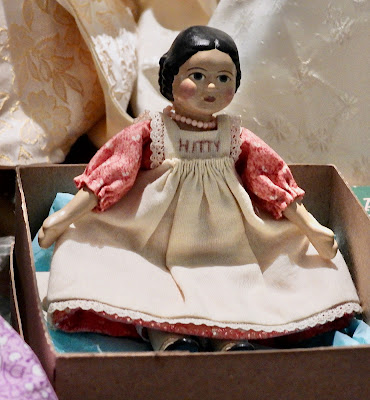Elaine Jackson and Elaine McNally did a joint program on Hitty and her friends. Hitty is the wooden doll heroine of Rachel Field's 1929 children's novel, Hitty, Her First Hundred Years. In the book, the eponymous Hitty (short for Mehitabel), a simple wooden doll carved by a peddler in the 1820s, narrates her adventures over her century of existence. Jackson explained that Fields was friends with illustrator Dorothy Lathrop and sometime in the 1920s, while strolling together in New York City they saw a small time-worn wooden doll in an antique shop window. All the shop owner could tell them about the doll was that she was at least 100 years old. Neither woman could afford the doll by herself, so they pooled their resources and purchased her jointly. Inspired by the diminutive doll, they created a history for Hitty, written by Fields and illustrated by Lathrop. The book was a success and was awarded the John Newbery Medal of Excellence in 1930. Elaine brought several examples of Hitty, which is still in print.
The book's charming historical tale has inspired generations of doll artists to carve their own versions of Hitty based on the book's illustrations, as well as Hitty-type dolls referred to as Hitty friends.
This an early all-wood Hitty was carved by Helen Bullard, one of the founders of the National Institute of American Doll Artists. Jackson explained that because of copyright issues, Bullard called her doll "Holly." People began to wonder what had happened to the original Hitty and Jackson stated that in the 1980s Hitty was discovered in the Stockbridge Library in Massachusetts, where she had been donated by a relative of Lathrop. The original Hitty now resides in a climate-controlled case donated by the Friends of Hitty.
The copyright has since expired and artists now may call their creations "Hitty." Michael Langton persuaded the Stockbridge to permit him to measure the original Hitty and he created Hitty replicas both in wood and resin. This doll, belonging to Elaine McNally, is actually a perfume bottle created by Langton.
Jackson displayed a wide variety of Hitty dolls in wood and resin, showing each artist's own unique interpretation of the beloved doll.
This doll by Sara Cole is made of resin. Using resin allows an artist to make multiple editions of a doll.
This Hitty by Janet Cordell was a wooden shoulderhead on a cloth body.
Many of Jackson's Hitty dolls are souvenirs from Hitty conventions. This doll by Constance Hardt was the souvenir for a San Antonio convention called "Hitty at the Alamo."
Like many Hitty fans, Jackson has a "Hitty House" to display her Hitty dolls and friends. Jackson explained that Hitty is too large for a standard dollhouse and that her late husband built her a house suitable to Hitty's dimensions. This vintage handmade bed and chair are just the right size for many of Jackson's Hitty dolls. The bed was cleverly created out of an old wooden cigar box with clothespin posts and sewing spool legs.
Another wooden doll from Jackson's collection, this one representing "Miss Unity," the mascot of the United Federation of Doll Clubs. The doll was created by Judy Brown, who has also carved Hitty dolls.
Elaine McNally then displayed her wonderful whimsical dolls inspired by Hitty.
She showed the club the tools she uses to carve her creations.
McNally explained that she may start with a block of wood. . .
or use a commercially-made blank.
This Hitty holds a wooden whale. In the book, Hitty sails on a whaling ship.
A Hitty-inspired Alice in Wonderland cradling the Cheshire cat. McNally said that she enjoys creating miniature dolls holding an even smaller doll or other object.
This doll is an experiment by McNally to create a fully-jointed wooden doll.
McNally also makes little cloth versions of the rare Izannah Walker dolls, created in the 1840s through the 1880s.
Another version of Alice and the Cheshire cat.
This is McNally's tiny version of an Edith Flack Ackley doll. A writer and doll artist, in the 1930s Ackley published a book entitled Dolls to Make for Fun and Profit, which included patterns for dolls and their clothing. Many dolls were made using her patterns in the 1930s and 40s.
Guest Joey Gomez shared two of his Hitty dolls. This version is by Gail Wilson.
And this one is by Robert Raikes.
Myrna Loesche brought this little wooden girl carved by Austin artist Nancy Grobe, who was once a member of our club. Nancy eventually had to give up carving because of arthritis and became a skilled painter.
In honor of the Platinum Jubilee celebrating Queen Elizabeth's 75 years on the throne, members shared dolls representing English royalty. The Madame Alexander Cissy dolls and Cissette dolls belong to Myrna and date from the 1950s.
Although these dolls' costumes closely resemble the outfit worn by Queen Elizabeth II at her 1953 coronation, Alexander only referred to them as "Queen" dolls. This doll is all original except for the replacement crown created by Myrna.
This bisque-headed doll represents an earlier English queen, Queen Victoria. She is 9.5 inches tall and is all original. Her round paper tag reads "Fabrication Jumeau Paris Made in France" on one side and written in ink on back of label is "Victoria I Reine d Angleterre Cirque 1860." The head is incised "221 2/0." She is part of the "Femmes Célèbres" ("Great Ladies") series produced by Société Française de Bébé and Jouets (S.F.B.J.) in the 1940s. In 1899, a number of French doll makers, including Jumeau, joined in this alliance in an attempt to ward off German competition. S.F.B.J. (later under the name UNIS) produced dolls until the 1950s and continued to use the Jumeau name for some of its dolls.






























No comments:
Post a Comment